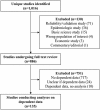Statistical Analysis of Dependent Observations in the Orthopaedic Sports Literature
- PMID: 30637265
- PMCID: PMC6317150
- DOI: 10.1177/2325967118818410
Statistical Analysis of Dependent Observations in the Orthopaedic Sports Literature
Abstract
Background: Orthopaedic research may involve multiple observations from the same patient because of bilateral joint involvement, multiple disease sites, or recurrent disease episodes. These situations violate statistical independence and need to be accounted for via appropriate statistical techniques. Failing to account for nonindependence may lead to biased and overly precise effect estimates.
Purpose: To determine the degree to which orthopaedic sports medicine studies analyze dependent observations and the proportion of these failing to account for nonindependence.
Study design: Cross-sectional study.
Methods: Clinical studies published in The American Journal of Sports Medicine from 2012 to 2017 were reviewed. Studies reporting nonindependent observations because of multiple extremity involvement or multiple disease episodes were identified. Methods to account for nonindependence were recorded. Studies violating the assumption of independence were identified and stratified by study design, level of evidence, body part involved, and inclusion of a statistician coauthor. Univariate logistic regression was used to determine whether these factors were associated with violations of statistical independence.
Results: After screening 1016 articles, 886 clinical studies were reviewed. A total of 135 (15%) studies analyzed dependent observations, and 111 (82%) of these failed to account for nonindependence. Relative to the knee, studies of the hip (odds ratio [OR], 0.21; P = .02) and the thigh or leg (OR, 0.03; P = .004) were less likely to violate statistical independence. Study design (P = .03) was also associated with violations of statistical independence. Among studies that analyzed dependent observations, the median proportion of dependent observations relative to the total number of observations in each study was 0.07 (interquartile range, 0.04-0.12).
Conclusion: The analysis of dependent observations is common in the orthopaedic sports literature, but most studies do not adjust for nonindependence in these situations. Investigators should be aware of incorrect inferences arising from nonindependence and how to statistically adjust for dependent data.
Keywords: bilaterality; epidemiology; nonindependence; statistics.
Conflict of interest statement
One or more of the authors has declared the following potential conflict of interest or source of funding: M.S.K. is a consultant for OrthoPediatrics, Smith & Nephew, and Stryker. AOSSM checks author disclosures against the Open Payments Database (OPD). AOSSM has not conducted an independent investigation on the OPD and disclaims any liability or responsibility relating thereto.
Figures
Similar articles
-
How Often Do Orthopaedic Matched Case-Control Studies Use Matched Methods? A Review of Methodological Quality.Clin Orthop Relat Res. 2019 Mar;477(3):655-662. doi: 10.1097/CORR.0000000000000612. Clin Orthop Relat Res. 2019. PMID: 30614911 Free PMC article.
-
Statistical consideration for bilateral cases in orthopaedic research.J Bone Joint Surg Am. 2010 Jul 21;92(8):1732-7. doi: 10.2106/JBJS.I.00724. J Bone Joint Surg Am. 2010. PMID: 20660236
-
An assessment of statistical methods for nonindependent data in ecological meta-analyses.Ecology. 2020 Dec;101(12):e03184. doi: 10.1002/ecy.3184. Epub 2020 Oct 7. Ecology. 2020. PMID: 32893349
-
Predictors of 5-Year Citation Rate in the Orthopaedic Sports Medicine Literature.Am J Sports Med. 2019 Jan;47(1):206-211. doi: 10.1177/0363546518810504. Epub 2018 Nov 27. Am J Sports Med. 2019. PMID: 30481045
-
Minimum Clinically Important Difference: Current Trends in the Orthopaedic Literature, Part II: Lower Extremity: A Systematic Review.JBJS Rev. 2018 Sep;6(9):e2. doi: 10.2106/JBJS.RVW.17.00160. JBJS Rev. 2018. PMID: 30179898
Cited by
-
Partially clustered designs for clinical trials: Unifying existing designs using consistent terminology.Clin Trials. 2023 Apr;20(2):99-110. doi: 10.1177/17407745221146987. Epub 2023 Jan 10. Clin Trials. 2023. PMID: 36628406 Free PMC article. Review.
-
Statistical Assumptions in Orthopaedic Literature: Are Study Findings at Risk?Cureus. 2021 Oct 12;13(10):e18694. doi: 10.7759/cureus.18694. eCollection 2021 Oct. Cureus. 2021. PMID: 34786266 Free PMC article.
-
An in-depth analysis of young adults with osteonecrosis secondary to developmental dysplasia of the hip who underwent total hip arthroplasty.BMC Musculoskelet Disord. 2024 Jun 4;25(1):436. doi: 10.1186/s12891-024-07517-8. BMC Musculoskelet Disord. 2024. PMID: 38835008 Free PMC article.
-
Sample Size Calculations for Partially Clustered Trials.Stat Med. 2025 Jul;44(15-17):e70172. doi: 10.1002/sim.70172. Stat Med. 2025. PMID: 40662648 Free PMC article.
-
Using bilateral data in controls and patients with bilateral and unilateral pathology requires increased scrutiny.J Biomech. 2024 Jan;162:111855. doi: 10.1016/j.jbiomech.2023.111855. Epub 2023 Oct 30. J Biomech. 2024. PMID: 37984294 Free PMC article.
References
-
- Aarts E, Verhage M, Veenvliet JV, Dolan CV, van der Sluis S. A solution to dependency: using multilevel analysis to accommodate nested data. Nat Neurosci. 2014;17(4):491–496. - PubMed
-
- Agricola R, Bessems JH, Ginai AZ, et al. The development of cam-type deformity in adolescent and young male soccer players. Am J Sports Med. 2012;40(5):1099–1106. - PubMed
-
- Beckmann JT, Wylie JD, Kapron AL, Hanson JA, Maak TG, Aoki SK. The effect of NSAID prophylaxis and operative variables on heterotopic ossification after hip arthroscopy. Am J Sports Med. 2014;42(6):1359–1364. - PubMed
-
- Bhandari M, Morrow F, Kulkarni A, Tornetta P. Meta-analyses in orthopaedic surgery: a systematic review of their methodologies. J Bone Joint Surg Am. 2001;83(1):15–24. - PubMed
-
- Bryant D, Havey T, Roberts R, Guyatt G. How many patients? How many limbs? Analysis of patients or limbs in the orthopaedic literature: a systematic review. J Bone Joint Surg Am. 2006;88(1):41–45. - PubMed
LinkOut - more resources
Full Text Sources


